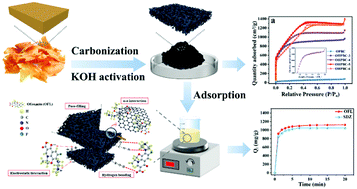Hierarchical porous biochar with ultra-high specific surface area for rapid removal of antibiotics from water†
Abstract
Improving the adsorption speed and capacity of adsorbents is essential for the removal of antibiotic pollutants in water. Herein, hierarchical porous biochars (OHPBCs) with an ultrahigh specific surface area and an effectively adjustable pore structure were prepared using a waste, onion skin, by a facile chemical activation strategy. The as-prepared OHPBC-5 exhibited the maximum specific surface area of 3787.6 m2 g−1 and a pore volume of 1.95 cm3 g−1. OHPBC-5 presented a rapid adsorption equilibrium (within 10 min), and the maximum adsorption capacities towards ofloxacin (OFL) and sulfadiazine (SDZ) were 1134.76 and 1281.25 mg g−1, respectively. The pseudo-second-order kinetics model and Langmuir isotherm model were suitable for analyzing the adsorption process of OHPBC-5 to OFL and SDZ, indicating that the adsorption of OFL and SDZ on OHPBC-5 was the chemisorption on homogenous surface. Besides, OHPBC-5 provided a wide applicable pH range and ionic strength concentration. Furthermore, the removal mechanism of OFL and SDZ was analyzed and discussed systematically. More importantly, OHPBC-5 could be regenerated and reused three times without significant reduction in its adsorption capacity. OHPBC-5 also showed highly efficient adsorption performance for tetracycline (exceeded 900 mg g−1) and macrolide (exceeded 500 mg g−1) antibiotics. And it also maintained a high removal efficiency in real river water environment. This study can provide a reference for the preparation of high-efficiency adsorbents from waste biomass for wastewater treatment.



 Please wait while we load your content...
Please wait while we load your content...